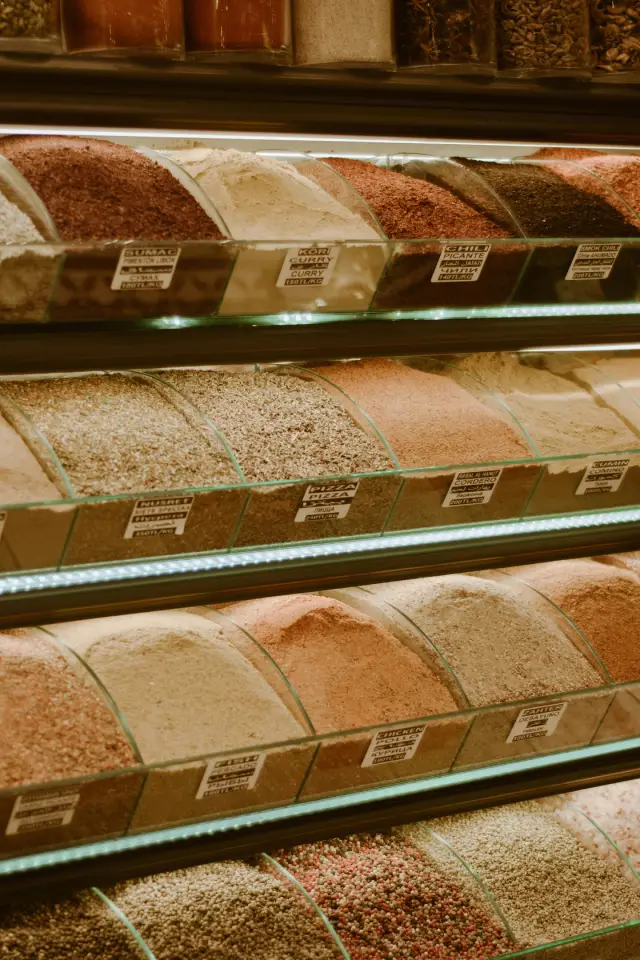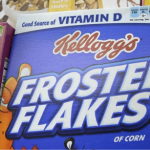How to go shopping for food

Whilst I’m a huge advocate for eating real foods (AKA foods without labels), I know that there is always going to be times where we are going to opt for food with labels.
To help overcome this hurdle with confidence, below is a list of tips and tricks that will help you skip the nasties found in packaged foods and ensure you return home with some nutritious and delicious ingredients for your next meal. You could even commit to following this guide and clean out your pantry on a rainy weekend. Trust me, you’ll be surprised what you’ll find!
#1 READ THE INGREDIENTS
Yes you read correctly, skip the nutrition panel! The list of ingredients will tell you more than enough information about what you are about to consume. If the ingredients list contains anything that you can’t pronounce (except quinoa, acai and cacao or if you are an expat new to the Dutch language ), any laboratory numbers (311, 142, 209 etc.), contains flavours, preservatives, sounds chemically or is incredibly lengthy (2-3 lines +), step away – it’s not real food and it’s most definitely not worth it.
#2 BEWARE OF TICKS OF APPROVAL
Ticks of approval are given to products where they have studied the nutritional label, they don’t take into consideration the ingredients or the processing methods. This means any of the above (in Rule #1), can be included without their consideration.
#3 BEWARE OF LOW FAT AND LOW SUGAR CLAIMS
In most cases, foods that are low fat or contain low/no sugar have been chemically modified and these are in no way good for your health (despite what the shiny labels might tell you). Ditch the plastic and eat a banana instead.
#4 BEWARE OF GREEN WASHING
Natural foods are flying off shelves; it’s little wonder the label is everywhere. The FDA hasn’t defined natural and doesn’t regulate its use, so companies can—and do—use it however they like to increase sales. All natural foods are fruits and vegetables and not one of them come with an all natural label – use common sense.
#5 ORGANIC OR CERTIFIED ORGANIC?
If a label claims to be organic, ensure it is certified organic. That means this sign below:

#6 JUST BECAUSE IT’S GLUTEN FREE OR WHATEVER BUZZ WORD-FREE, DOESN’T MEAN IT’S HEALTHY
“Gluten-Free” is the new buzz word and many companies are marketing their products as ‘gluten-free’ and hence, in the eye of some consumers, a healthier, “guilt free” alternative. Like the “fat free” movement that stripped the goodness from so many healthy foods like that of avocados, nuts, seeds and eggs and replaced it with fat-free yoghurt that contained three times the sugar, gluten free processed food is not a healthier alternative. Whether it is a store bought “gluten-free” triple chocolate brownie with macadamia and chocolate fudge icing or a “gluten free” processed rice cracker covered in artificial colours, flavours and preservatives, neither of these are a healthier alternative just because they contain no gluten. These products often contain soy flours, soybean oil, canola oil, hydrogenated vegetable proteins which are extremely damaging to your health. Same for sugar-free, superfoods, all-natural, vegan, vegetarian, made with real fruit, GMO-free, cage-free etc. Keep it simple, JUST EAT REAL FOOD, fruits, vegetables, seeds, nuts, grass-fed meats, pasture-fed eggs, wild-caught fish… are all 100% gluten free, naturally.
# 7 LOW FAT MEANS LOADED WITH SUGAR
“Low fat” labels require that the fat of the original product must be reduced 25%, but that doesn’t stop the manufacturer from adding taste with more sugar. Low fat yoghurts are the biggest culprits and have been known to contain 3 times the sugar of 100% organic full-fat alternatives. Sugar makes us fat, always opt for the full-fat organic varieties with NO added sugar or sweeteners.
To illustrate my point, a small snack size tub of yoghurt labelled “99% fat free with 40% of your RDI of calcium and enriched with vitamin D for strong bones” contains a whopping 22.8grams of sugar (equivalent to just shy of 6 tsp). Skip it, it won’t keep you satisfied and will only make you reach for another sugar fix an hour later.

#8 DON’T BLINDLY TRUST THE BRAND NAME
A well known “reliable” brand was had some controversy with a packet of dried dates. The well known brand had exactly the same ingredients: dates and palm oil, as other brands that weren’t marketed to be the “healthy” brand.
Be wary of your choices and make sure you are making the right choice, especially if they are making you pay for it.
#9 WHOLE-WHEAT DOESN’T MEAN WHOLE GRAIN
While I am not a huge advocate of grains, I needed to cover this one for all those grain lovers out there. A label of “whole wheat” doesn’t mean that only whole grains are in the product. It means that some whole grains are in it. You could have 90% white flour, and 10% whole wheat flour, and call it “whole wheat”. Cereal companies (never eat cereal by the way. If you want to know why, flip over to the nutrition label and see how much sugar is in it) and bread manufacturers are guilty of this one. If you are set on buying grains, opt for “100% organic non GMO whole grain.”
Food manufactures use an array of clever marketing strategies in an attempt to convince consumers that their new and improved products are “better for you”, when they are really just “less awful for you.” This skews our perception of what it really means to be healthy and as such, our relationship with our food and eventually our perception of well being, spirals out of control and we end up in a world of doubt, depression and frustration. Sound familiar? Want my best advice? You need to get food educated…
#10 SUGAR FREE USUALLY MEANS DANGEROUS ARTIFICIAL ADDITIVES
Products claiming to be low in sugar or sugar-free are usually artificially sweetened with products containing aspartame. Aspartame, like MSG, is an excitotoxin. It is comprised of methanol, phenylalanine and aspartic acid. Aspartame can be found in diet sodas and most other diet products however, research indicates that the sweetener increases your hunger and can actually work against your weight loss. Aspartame has also been linked to cancer, birth defects, vision problems, brain seizures and diabetes. Skip the sugar-free sweetness kick and grab an apple instead.
for your content.
#11 BEWARE OF GREEN PACKAGING
According to research green is a found-in-nature color, so we associate it with health, even when we shouldn’t. One study in the journal Health Communication found that consumers are more likely to think a snack bar with a green label is healthier than those with white or red labels–even if they are identical in every other way. If you are buying packaged foods, read the list of ingredients, don’t be tempted by the colour of the packaging, green does not necessarily mean healthy.

#12 MADE WITH ORGANIC INGREDIENTS
The “Made With Organic Ingredients” label means the food must be made with at least 70 percent organic ingredients, three of which must be listed on the package. The remaining 30 percent can be anything the production team decide and may include harsh chemicals or additives you thought you were avoiding, this is especially the case with beauty products, be wary. Again, why we say to read the ingredient list first.
#13 MADE WITH “ADDED VITAMINS”
Designed to make us think this form of processed food comes with all the benefits of fruits and veggies, this label is prevalent in the cereal (again, don’t eat cereal, you’ll get more nutition eating the cardbox box that the cereal is packaged in rather than the ceral itself), bread and snack aisles of the supermarket. Vitamins A, C, E and the Bs are added to cereal, breads and lunchbox snacks. The truth? Science shows that separating vitamins and minerals from one food and putting them in another doesn’t offer the same disease-fighting benefits. More often than not these added vitamins are synthetic forms and are nowhere near as beneficial to your health. Get your vitamins, minerals and antioxidants from real, whole foods, like veggies, fruits, whole grains and lean meats.

#14 BEST BEFORE 2026?
If the product you have purchased has a shelf life longer than you have owned your mobile phone, ditch it. We eat foods to gain life, to replenish our cells, muscles and organs to help us thrive. Food that nourishes our body is a perishable item i.e. strawberries last 4-5 days, broccoli lasts 10-12 days, beef best before 3-5 days, some biscuits on shelves today expire in November 2026… Foods lasting longer than your i-phones operating software system upgrade aren’t real foods and you will get no benefit from them. Eat to nourish your body and ditch the cardboard.
#15 BAKED NOT FRIED
Most consumers associate the word “baked” with “healthy”. This would certainly be true in home cooking: a baked potato, for example, would be a more nourishing choice than a fried potato however, this is not necessarily the case for foods found on the supermarket shelves. These goods are often baked in highly processed vegetable oils that still damage our health, check your list of ingredients.
#16 IF YOU CAN’T PRONOUNCE THE INGREDIENTS, DON’T EAT THEM.
If you flip over the package of any processed food and can’t pronounce some of the items listed in the ingredients list, don’t eat them. They are artificial in every way shape and form and will only cause your body to struggle. Those learning Dutch and unable to pronounce the words are
exempt ![]()
